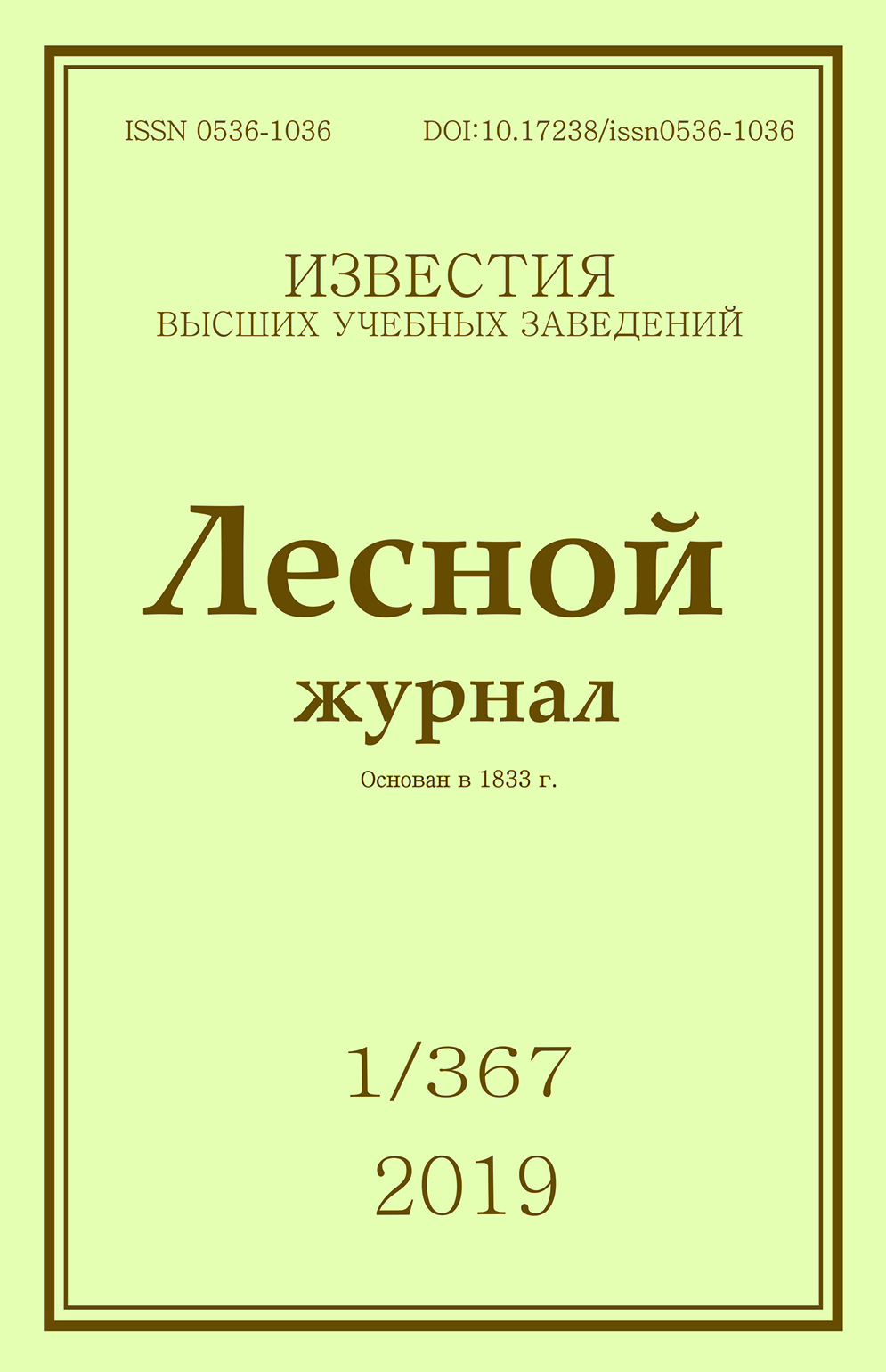Formation of Picea abies (L.) Karst. Trunk Wood in Different Taiga Zone Communities
Keywords:
Picea abies (L.) Karst., anatomy, annual ring, wood, forest typesAbstract
Much attention is given to the trunk wood of forest-forming species of primary forest
communities in studying biological productivity of forest stands. We have carried out the research in the middle taiga subzone (South Karelia) in 2014 in order to determine the influence of site conditions on anatomical indicators of trunk wood of Picea abies (L.) Karst. Study objects were the most common types of forest communities for the region. Five test plots were grounded. Twenty trees of II–III classes of growth and development (according to Kraft’s classification) were chosen on each of the plots. Hewings of the trunk wood were picked at the end of the vegetation period at a height of 1.3 m; increments for the last 3 years were analyzed. Preparations were made from the hewings. Width of the tree-ring, width of the autumn wood zone and number of tracheid rows were measured on the preparations in three spots. It was found that tree-ring width and wood quality decrease with deterioration of the site conditions. This indicator in sorrel spruce forest (3.59 mm) is 3.6, 5.6, 8.8 and 11.6 % higher in comparison with myrtillus, vaccinium, swampy with grass and sphagnum spruce forests respectively. Furthermore, larger number of tracheid rows (51 pcs) is formed in sorrel spruce forest in comparison with myrtillus, vaccinium, swampy with grass and sphagnum spruce forests by 5.9, 15.7, 20.0 and 27.5 % respectively; as well as the greatest width of autumn wood zone (1.37 mm). The last indicator in myrtillus, vaccinium, swampy with grass and sphagnum spruce forests is 7.9, 13.6, 20.0 and 28.6 % less respectively. Proportion of autumn wood reaches its maximum in sorrel spruce forest (38.9 %) during the tree-ring formation. Values of this indicator in myrtillus, vaccinium, swampy with grass and sphagnum spruce forests are 37.1, 36.0, 34.6 and 34.1 %
respectively.
Downloads
References
Антонова Г.Ф., Стасова В.В. Формирование годичного слоя древесины стволов сосны обыкновенной и лиственницы сибирской // Лесоведение. 1992. № 5. С. 19−27.
Бабич Н.А., Мелехов В.И., Антонов А.М., Клевцов Д.Н., Коновалов Д.Ю. Влияние условий местопроизрастания на качество древесины сосны (Pinus sylvestris L.) в посевах // Хвойные бореальной зоны. 2007. Т. XXIV, № 1. С. 54−58.
Ванин С.И. Об изучении анатомического строения древесины // Тр. Ин-та леса АН СССР. 1949. № 4. С. 26−43.
Кищенко И.Т. Влияние условий местопроизрастания на анатомическое строение годичного кольца Pinus sylvestris L. в таежной зоне // Принципы экологии. 2014. Т. 3, № 2. С. 26–32. DOI: 10.15393/j1.art.2014.3602
Кроткевич П.Г. Выращивание высококачественной древесины. М.; Л.: Гослесбумиздат, 1955. 180 с.
Мелехов И.С. О качестве северной сосны. Архангельск: Сев. изд-во, 1932. 21 с.
Мелехов В.И., Бабич Н.А., Корчагов С.А. Качество древесины сосны в культурах. Архангельск: Изд-во АГТУ, 2003. 110 с.
Полевая геоботаника / под общ. ред. Е.М. Лавренко и А.А. Корчагина. М.; Л.: Наука, 1964. Т. 3. 530 с.
Программа и методика биогеоценологических исследований / отв. ред. Н.В. Дылис. М.: Наука, 1974. 404 с.
Сахаров М.И. Анатомическое строение древесины сосны (Pinus silvestris L.) в связи с условиями местопроизрастания // Тр. Брянск. с.-х. ин-та. 1940. Т. 2. С. 287301.
Сукачев В.Н. Избр. тр.: в 3 т. Т. 1. Основы лесной типологии и биогеоценологии. Л.: Наука, 1972. 418 с.
Чумаченко С.И., Степаненко И.И. Влияние классов роста и размеров крон деревьев на строение древесины сосны с внесением минеральных удобрений // Лесн. вестн. 2007. № 6. С. 713.
Яценко-Хмелевский А.А. Основы и методы анатомического исследования древесины. М.; Л.: Изд-во АН СССР, 1954. 338 с.
Blokhina N.I., Bondarenko O.V., Osipov S.V. Age Variation of Wood Anatomical Characteristics in Larix cajanderi Tree // Wood Research Journal. 2011. Vol. 2, no. 1. Pp. 1–12.
Deslauriers A., Morin H. Intra-Annual Tracheid Production in Balsam Fir Stems and the Effect of Meteorological Variables // Trees. 2005. Vol. 19, iss. 4. Pр. 402–408.
Fritts H.С. Tree-Ring and Climate. London: Academic Press., 1976. 582 p.
Iawa List of Microscopic Features for Softwood Identification / ed. by Richter H.G., Grosser D., Heinz I. and Gasson P.E. // IAWA Journal. 2004. Vol. 25(1). Pp. 1–70.
Larson P.R. The Vascular Cambium. Development and Structure. Berlin: SpringerVerlag GmbH, 1994. 725 p.
Odin H. Studies of the Increment Rhythm of Scots Pine and Norway Spruce Plants // Studia Forestalia Suecica. 1972. No. 97. Pp. 1–32.
Rossi S., Deslauriers A., Morin H. Application of the Gompertz Equation for the Study of Xylem Cell Development // Dendrochronologia. 2003. Vol. 21, iss. 1. Pр. 33–39.
Whitmore F.W., Zahner R. Development of the Xylem Ring in Stems of Young Red Pine Trees // Forest Science. 1966. Vol. 12, iss. 2. Pp. 198–210.
Wilson R., Elling W. Temporal Instability of Tree-Growth/Climate Response in the Lower Bavarian Forest Region: Implications for Dendroclimatic Reconstruction // Trees. 2004. Vol. 18(1). Pр. 19–28.







